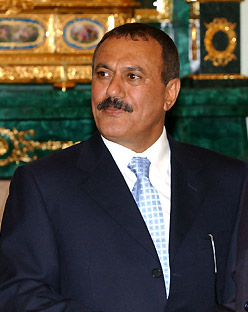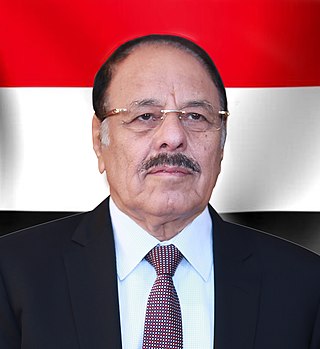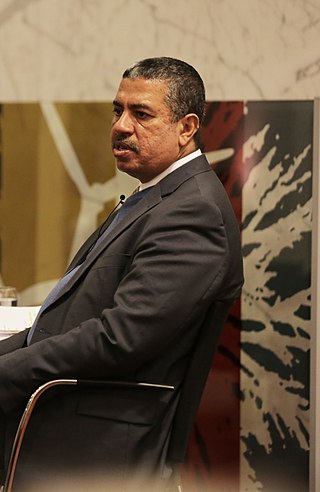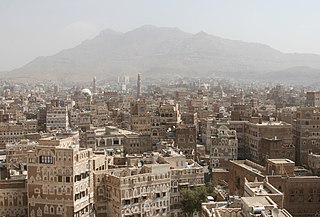| |||||
| Decades: | |||||
|---|---|---|---|---|---|
| See also: | Other events of 2006 | ||||
The following lists events that happened during 2006 in Yemen .
| |||||
| Decades: | |||||
|---|---|---|---|---|---|
| See also: | Other events of 2006 | ||||
The following lists events that happened during 2006 in Yemen .

The USS Cole bombing was a suicide attack by the terrorist group al-Qaeda against USS Cole, a guided missile destroyer of the United States Navy, on 12 October 2000, while she was being refueled in Yemen's Aden harbor.

Ali Abdullah Saleh al-Ahmar was a Yemeni politician who served as the first President of Yemen, from Yemeni unification on 22 May 1990 to his resignation on 25 February 2012, following the Yemeni Revolution. Previously, he had served as President of the Yemen Arab Republic, or North Yemen, from July 1978 to 22 May 1990, after the assassination of President Ahmad al-Ghashmi.

Jamal Ahmad Mohammad Ali Al Badawi aka Jamal Abu Abed Al Rahman Al Badawi was a Yemeni who was indicted as an accomplice for his role in the 2000 USS Cole bombing off the coast of Aden, Yemen, which killed 17 American sailors on 12 October 2000. He was captured in Yemen and sentenced to death on 29 September 2004. Al-Badawi was also indicted on 15 May 2003, by the United States for the USS Cole bombing and the attempted attack on USS The Sullivans. He is thought to have travelled to Saudi Arabia and purchased a small boat and then a truck and trailer to transport it. This boat sank from the weight of the explosives while preparing the USS The Sullivans plot. Al-Badawi is also thought to have leased the safehouses used in these endeavors. Fox News called Al-Badawi a "mastermind" of the Cole bombing.
Fawaz Yahya al-Rabeiee was an al-Qaeda terrorist, sentenced to death in 2004 by a Yemeni court for his part in the 2002 attack on the French tanker Limburg. Al-Rabeiee escaped custody in February 2006, with 22 other inmates, but was killed 1 October 2006 in San‘a’, along with another al-Qaeda suspect identified as Mohammed Daylami.
Issam Ahmad Dibwan al-Makhlafi, aka Akrama, became briefly wanted in 2002, by the United States Department of Justice's FBI, which was then seeking information about his identity and whereabouts. In early 2002, he had been named in a suspected Yemen plot, for which he became listed on the FBI's third major "wanted" list, now known as the FBI Seeking Information - War on Terrorism list. He was identified as a known associate of the Yemen cell leader, Fawaz Yahya al-Rabeei. But he was quickly discovered to already be in Yemen prison, and was promptly removed from the FBI "wanted" list. Very little else is known about him.
Ahmad al-Akhader Nasser Albidani, , became briefly wanted in 2002, by the United States Department of Justice's FBI, which was then seeking information about his identity and whereabouts. In early 2002, he had been named in a suspected Yemen plot, for which he became listed on the FBI's third major "wanted" list, now known as the FBI Seeking Information – War on Terrorism list. He was identified as a known associate of the Yemen cell leader, Fawaz Yahya al-Rabeei. But he was quickly discovered to already be in Yemen prison, and was promptly removed from the FBI "wanted" list. Very little else is known about him.
Bashir Ali Nasser al-Sharari became briefly wanted in 2002, by the United States Department of Justice's FBI, which was then seeking information about his identity and whereabouts. In early 2002, he had been named in a suspected Yemen plot, for which he became listed on the FBI's third major "wanted" list, now known as the FBI Seeking Information - War on Terrorism list. He was identified as a known associate of the Yemen cell leader, Fawaz Yahya al-Rabeei. But he was quickly discovered to already be in Yemen prison, and was promptly removed from the FBI "wanted" list. Very little else is known about him.
Abdulaziz Muhammad Saleh bin Otash, became briefly wanted in 2002, by the United States Department of Justice's FBI, which was then seeking information about his identity and whereabouts. In early 2002, he had been named in a suspected Yemen plot, for which he became listed on the FBI's third major "wanted" list, now known as the FBI Seeking Information – War on Terrorism list. He was identified as a known associate of the Yemen cell leader, Fawaz Yahya al-Rabeei. But he was quickly discovered to already be in Yemen prison, and was promptly removed from the FBI "wanted" list.
Shuhour Abdullah Mukbil al-Sabri, , became briefly wanted in 2002, by the United States Department of Justice's FBI, which was then seeking information about his identity and whereabouts. In early 2002, he had been named in a suspected Yemen plot, for which he became listed on the FBI's third major "wanted" list, now known as the FBI Seeking Information – War on Terrorism list. He was identified as a known associate of the Yemen cell leader, Fawaz Yahya al-Rabeei. But he was quickly discovered to already be in Yemen prison, and was promptly removed from the FBI "wanted" list. Very little else is known about him.
Abdullah Al-Rimi or Abdullah Ahmed Al-Remi,, has been described as an "important al-Qaeda recruiter", and became wanted in 2006 by the United States Department of Justice's FBI, "sought in connection with possible terrorist threats against the United States." He was one of 23 people who escaped from Yemen prison in San'a, including the Yemen cell leader, Fawaz Yahya al-Rabeei. Several weeks later he became listed on the FBI's third major "wanted" list, the FBI Seeking Information – War on Terrorism list. Very little else is known about him.

In the years after the September 11, 2001 attack on the World Trade Center in New York City, Yemen became a key site for U.S. intelligence gathering and drone attacks on Al-Qaeda. According to the 2012 U.S. Global Leadership Report, 18% of Yemenis approved of U.S. leadership, with 59% disapproving and 23% uncertain. According to a February 2015 report from the Congressional Research Service, U.S. officials considered Al-Qaeda in the Arab Peninsula the Al-Qaeda affiliate "most likely to attempt transnational attacks against the United States."
Twenty-three suspected Al-Qaeda members escaped from a Yemen prison in 2006. The escape is notable because the escapees included several individuals imprisoned for their participation in the USS Cole bombing. Gaber Al-Bana’a was believed to be an American citizen, who traveled to an Afghan training camp with some friends who became known as the Lackawanna Six or Buffalo Six, when they were rounded up as a "sleeper cell".

Abdrabbuh Mansur Hadi is a Yemeni politician and former field marshal of the Yemeni Armed Forces who served as the president of Yemen from 2012 until 2022, when he stepped down and transferred executive authority to the Presidential Leadership Council, with Rashad al-Alimi as its chairman. He was the vice president to Ali Abdullah Saleh from 1994 to 2012.

The Yemeni Revolution (intifada), also known as the Yemeni Revolution of Dignity followed the initial stages of the Tunisian Revolution and occurred simultaneously with the Egyptian Revolution of 2011 and other Arab Spring protests in the Middle East and North Africa. In its early phase, protests in Yemen were initially against unemployment, economic conditions and corruption, as well as against the government's proposals to modify Yemen's constitution. The protesters' demands then escalated to calls for the resignation of Yemeni President Ali Abdullah Saleh. Mass defections from the military, as well as from Saleh's government, effectively rendered much of the country outside of the government's control, and protesters vowed to defy its authority.

Ali Mohsen Saleh al-Ahmar, sometimes spelled "Muhsin", is a Yemeni military officer who served as the vice president of Yemen from 2016 to 2022, when he was dismissed by President Abdrabbuh Mansur Hadi, who transferred the powers of the president and vice president to the Presidential Leadership Council. He is a general in the Yemeni Army and was the commander of the northwestern military district and the 1st Armoured Division. He played a leading role in the creation of the General People's Congress.

Khaled Mahfoudh Bahah is a Yemeni politician and diplomat who served as Prime Minister of Yemen between 2014 and 2016, as well as Vice President of Yemen from 2015 until he was fired on April 3, 2016, by President of Yemen Abdrabbuh Mansur Hadi.

The following is a timeline of the 2011–2012 Yemeni revolution from 23 September through December 2011. The Yemeni revolution was a series of major protests, political tensions, and armed clashes taking place in Yemen, which began in January 2011 and were influenced by concurrent protests in the region. Hundreds of protesters, members of armed groups, army soldiers and security personnel were killed, and many more injured, in the largest protests to take place in the South Arabian country for decades.

The Yemeni Crisis began with the 2011–2012 revolution against President Abdullah Saleh, who had led Yemen for 33 years. After Saleh left office in early 2012 as part of a mediated agreement between the Yemeni government and opposition groups, the government led by Saleh's former vice president, Abdrabbuh Mansur Hadi, struggled to unite the fractious political landscape of the country and fend off threats both from Al-Qaeda in the Arabian Peninsula and from Houthi militants that had been waging a protracted insurgency in the north for years.

The Battle of Sanaa in 2014 marked the advance of the Houthis into Sanaa, the capital of Yemen, and heralded the beginning of the armed takeover of the government that unfolded over the following months. Fighting began on 9 September 2014, when pro-Houthi protesters under the command of Abdul-Malik al-Houthi marched on the cabinet office and were fired upon by security forces, leaving seven dead. The clashes escalated on 18 September, when 40 were killed in an armed confrontation between the Houthis led by military commander Mohammed Ali al-Houthi and supporters of the Sunni hardliner Islah Party when the Houthis tried to seize Yemen TV, and 19 September, with more than 60 killed in clashes between Houthi fighters and the military and police in northern Sanaa. By 21 September, the Houthis captured the government headquarters, marking the fall of Sanaa.

The aftermath of the Houthi takeover in Yemen refers to developments following the Houthis' takeover of the Yemeni capital of Sana'a and dissolution of the government, which eventually led to a civil war and the Saudi Arabian-led intervention in Yemen.